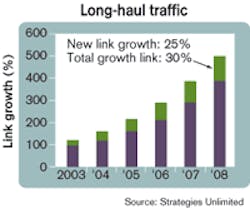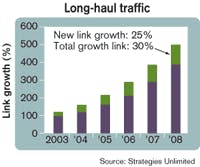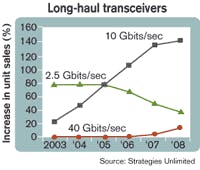40G optical networks: why, how, and when?
The unveiling of Concorde in the late 1960s heralded a new era in air travel. The supersonic aircraft was so much faster and more powerful than its predecessors that it surely had to be the technology of the future. But things didn’t turn out as hoped-in the end, Concorde just wasn’t commercially viable, while smaller jets are still selling well. The question for players in today’s telecommunications industry is this: Will 40 Gbits/sec be the next cargo jet or the next Concorde?
The big benefits of 40-Gbit/sec technology, according to its advocates, are a 50% smaller footprint than equivalent 10-Gbit/sec-based systems, 20-40% lower power requirements, and easier management (because there are 75% fewer wavelengths). And all of these benefits must lead to lower system costs, or carriers won’t even consider it.
Underlying these broader advantages are some more specific drivers for 40-Gbit/sec adoption, with router interfaces at the top of the list. It turns out that IP routers work a lot more efficiently if high-bit-rate data streams remain intact, rather than being demultiplexed to several lower-rate signals. And the router vendors have already demonstrated systems with 40-Gbit/sec interfaces.
Futureproofing and extending existing systems provides a further 40-Gbit/sec driver, with other potential markets, including transponders for test equipment and undersea applications. But while the next generation of networking equipment will doubtless meet carriers’ needs for 40-Gbit/sec compatibility, just how many of these high-data-rate interfaces are actually going to be deployed over the next few years?
A significant factor influencing the demand for 40-Gbits/sec is how traffic growth will play out. With the kind of growth rate witnessed of late, even being a little conservative, it won’t take too many years before the need for new channels goes through the roof. At that point, operators won’t want to fill all their racks with 10-Gbit/sec channels, which points to an inevitable demand for 40 Gbits/sec no later than about 2006 or ’07.Figure 2 shows Strategies Unlimited’s forecast for 2.5-, 10-, and 40-Gbit/sec LH-transceiver sales, based on traffic-growth expectations. Today, sales of 2.5-Gbit/sec devices are still strong, although all new systems are 10-Gbit/sec-capable. As 10-Gbit/sec sales hit full stride, 40 Gbits/sec will start to ramp up and continue to increase over the next few years. Once again, all of that depends on how traffic needs develop.
The uptake of 40 Gbits/sec will be further influenced by its ease of implementation-and the technology certainly comes with its own set of challenges. For starters, there are fewer photons per bit at higher bit rates, so the optical-signal-to-noise ratio goes down. That means a long-distance 40-Gbit/sec link is more expensive than a 10-Gbit/sec-based equivalent.
Moving from 10 to 40 Gbits/sec increases the chromatic and polarization-mode dispersion 16-fold and 2- to 4-fold, respectively, while 40-Gbit/sec components are not yet qualified in volumes. There are also some hidden costs, which include training technicians to use new systems, revamping operating systems, qualifying the fiber in the field, and requirements for more costly test equipment.
Another stumbling block is the electronics-whether indium phosphide or silicon germanium (SiGe)-which are still very expensive. If really pushed to its limits, CMOS can also work at 40 Gbits/sec, but it’s not necessarily better than SiGe because such leading edge lithography is pricey. What’s more, most of the cost of the electronics is in the testing, so CMOS doesn’t offer an advantage at high data rates.
Finally, in spite of what the vendors say, keeping a 40-Gbit/sec network running won’t actually turn out to be a trivial matter. It could be considered as similar to keeping a high-performance racing car tuned or perhaps even running Concorde.
Despite all these challenges and the fact that 40 Gbits/sec was a taboo subject until a few months ago, there has been a raft of product announcements and demonstrations of late. By exploiting Raman amplification, forward-error correction, dispersion engineering, and advanced modulation schemes such as carrier-suppressed return-to-zero (CS-RZ), duobinary, and differential phase shift keying, vendors are producing working 40-Gbit/sec systems. They also confirmed the feasibility of 40-Gbit/sec transmission over standard singlemode fiber-although that generally refers to post-1998 installations, not the oldest fiber in the ground.
So whereabouts in the network will 40 Gbits/sec make an impact? On the one hand, it’s easier to implement 40 Gbits/sec over shorter distances-and most router-to-router connections are within central offices and require a reach of <2 km. On the other hand, the highest data-rate links are usually thought of as being in LH (more than 80-km) networks, where aggregation is high enough to merit the extra effort and cost needed to install them.
The LH market is still slow, however, and vendors are pointing to metro networks as a third option. There will be some need for router-to-router links and an extension of existing systems in the metro, but without all the complexity of LH links.
Short-reach (SR) transponders will find applications in central offices and longer links, because they are used to hook up to transport equipment and routers. It looks like the SR-transponder vendors could win out either way; however, vendors of longer-haul racks need some metro or LH business to survive.
It’s often quoted that for 40 Gbits/sec to be competitive, the price per channel must be less than three times the 10-Gbit/sec price. That is not necessarily the case. First, 10 Gbits/sec was selling for some time at four and even 10 times the 2.5-Gbit/sec cost. Second, it depends on how the 40-Gbit/sec channel is used. If it extends a system and avoids a new fiber build, it may be worth it for a carrier, while for ultra-long links it may never pay off.One product to watch is the SR transponder, which is currently priced at about $30,000, although quantities are small. Customers require prices nearer to $8,000-$10,000 for their products to meet competitive targets. Note that this is still far more than the current cost of an SR 10-Gbit/sec transceiver, which comes in at around $500 when ordered in bulk. With reasonable expectations for price decline, the 40-Gbit/sec target could be reached by about 2007, which would then enable sales to take off.
Once 40 Gbits/sec has become established, what’s next for optical transmission? Over the last couple of decades, the introduction of new higher-data-rate channels into telecom systems has grown at about 26% per year. That equates to a doubling in data rate about every three years, or a move from 10 to 40 Gbits/sec in six years. This level of growth has led some people to project that the transition from 40 to 160 Gbits/sec will follow a similar trend.
On the other hand, the adoption of the newest data rate may follow a more classical S-curve. This scenario puts us in a period of about 19% per year growth, or doubling about every four years. In this case, 80 Gbits/sec might turn out to be the next logical step, since it can still use familiar electronics and can fit into a 100-GHz filter.
Technical conferences of late, such as ECOC last September, have included several presentations on 160-Gbit/sec innovations. Last July, Oki Electric in Japan demonstrated a 160-Gbit/sec link using optical TDM over 640 km. During last year, there was even a paper discussing 640-Gbit/sec serial transmission. However, you can’t increase the data rate indefinitely-there’s always a cost.
For one thing, there’s a physical limit to the optical power that a fiber can carry before nonlinearities distort the signal. As each bit requires at least one photon, at some point-maybe around 6 Tbits/sec-the data rate will hit its theoretical limit. And the shrinking reach at higher bit rates means the economic limit will come sooner.
A simulation performed in 2003 by the Technische Universität Berlin examined three 160-Gbit/sec networks: 16 × 10 Gbits/sec, 4 × 40 Gbits/sec, and a single serial 160-Gbit/sec channel. From a network management perspective, the serial 160-Gbit/sec channel was clearly the best, but 10 Gbits/sec came out on top for granularity and overall component cost. So perhaps 160 Gbits/sec will happen far out into the future, if it happens at all.
The key point, is that the best system will depend on exactly what the carrier is looking for, not just how high the data rate can reach. Carriers won’t necessarily come out on top just by ramping the bit rate. WDM technologies, for example, open up more choices. Also, the optical TDM technology that is used to achieve 160 Gbits/sec is like “changing four quarters for a dollar”-it is simply another kind of optical multiplexing. But if 40 or 160 Gbits/sec is not a sure choice, then those markets are more limited, and thus it becomes increasingly hard to get the price down.
Back to the here and now, it seems that 40 Gbits/sec is no longer taboo. Vendors are making slow but steady progress, and demand may be warming up. Strategies Unlimited expects some early adopters of 40-Gbit/sec-capable systems and 40-Gbit/sec router interfaces this year. If all goes well, sales look to likely start ramping up in 2007 and ’08.
If things don’t go as planned, perhaps 40 Gbits/sec will become the Concorde of the industry. Instead of larger and faster systems taking over, smaller, more granular systems will take the lead instead. After all, why buy a faster plane if you can’t fill the seats? More likely, 40 Gbits/sec will represent the end of the line for serial electronic data rates, with 80 and 160 Gbits/sec becoming the Concordes.
Traffic growth is the big thing to keep an eye on. As long as it’s expanding-even at annual rates far below the 100% that people like to believe-that’s good for 40 Gbits/sec. But it’s crucial to understand how carriers look at that and how badly they want to move to the next data rate. They certainly want their new equipment to be 40-Gbit/sec-compatible, and if they have it, chances are they will use it. On the other hand, whole industries have lost out by assuming that faster is necessarily better.Tom Hausken is director, optical components, at Strategies Unlimited. He can be reached at thausken@strategies-u.com. This article, based on Hausken’s presentation at the ECOC 2004 Market Forum in Stockholm, first appeared in the November 2004 issue of Fibre Systems Europe in Association with Lightwave Europe, p. 16.



